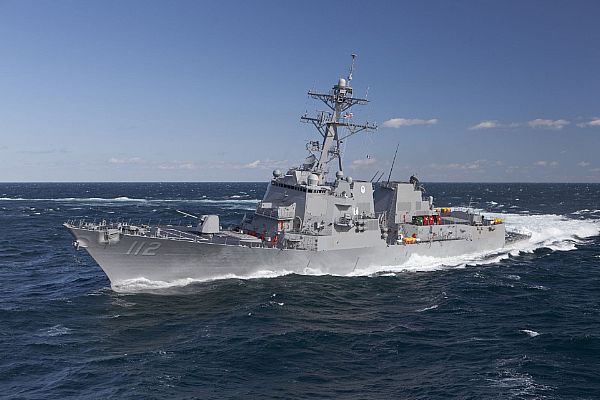Lockheed Martin will continue to modernize Aegis hardware and software onboard Navy vessels beyond Baseline 9. In the next phase of integrating the Aegis Combat System on the U.S. Navy’s fleet, Lockheed Martin has won a ten-year contract that will, with options, have the potential to be worth about $428 million.
The Ship Integration and Test (SI and T) program will integrate Aegis onboard new Arleigh Burke-class destroyers, and modernize destroyers and cruisers to operate the latest iteration of the Aegis configuration, called Baseline 9.
Through Baseline 9, ships can simultaneously defend against airborne threats, such as aircraft or cruise missiles, while also targeting and intercepting ballistic missiles. It is the only naval combat system in the world to demonstrate the ability to conduct integrated air and missile defense simultaneously.
The Aegis Weapon System in 1983 represented a true revolution in shipboard air defense. Based on an enormous investment in time, resources and management focus, Aegis was the first truly integrated ship-based system. It brought together radar and sensor detection, tracking and missile interception into a coherent, well-integrated weapon system.
It was originally focused primarily on the fleet air defense/anti-air warfare mission. Aegis has steadily expanded its mission set over the decades to successively include cruise missile defense, area theater ballistic missile defense, integrated air and missile defense (IAMD), and longer-range ballistic missile defense (BMD) cued by space-based sensors. (In Greek mythology, Aegis was the shield wielded by Zeus.) As more advanced radars and missiles enter the inventory in coming years, Aegis will play an increasingly important role in national BMD.
In mid-2014, Aegis was deployed on 84 ships: 22 cruisers and 62 destroyers.
The introduction of the Mk 41 Vertical Launching System (VLS), Tomahawk Land-Attack Missile (TLAM) and an integrated anti-submarine warfare (ASW) suite constituted Aegis Baseline 2.
Baseline 9 will deliver three major warfighting capability improvements. These are:
* the Naval Integrated Fire Control-Counter Air (NIFC-CA),
* Integrated Air and Missile Defense (IAMD) and
* Enhanced Ballistic Missile Defense.
The NIFC-CA capability for Baseline 9 cruisers and destroyers provides integrated fire control for theater air and anti-ship cruise missile defense, greatly expanding the over-the-horizon air warfare battle space for surface combatants by enabling third-party targeting of threats and use of “smart” missiles. NIFC-CA is valuable since it will allow greater performance of the Aegis radar over land and in the congested littorals where radar signals can be degraded given the topography and other local conditions. NIFC-CA allows Aegis to conduct over-the-horizon targeting using Standard anti-air missiles against targets based on data and other information received via the CEC net from off-board sensors such as enhanced E-2D Hawkeye aircraft.
IAMD brings the Fleet a more comprehensive capability to conduct ship self-defense, area air defense and ballistic missile defense missions at the same time. A core Navy mission driving capabilities for mobile, persistent, multi-mission Surface Forces, IAMD enables Aegis-equipped ships to optimize shipboard radar resources rather than forcing the radar to devote its energy to only one mission at a time. This full-up capability in all air- and missile-defense domains represents another major advance in the continuously evolving AWS capabilities against emerging threats.
Enhanced BMD comes with Baseline 9’s open architecture environment that will provide both a launch-on remote (LoR) and engage-on-remote (EoR) capability for Aegis where the interceptor missile uses tracking data provided from remote, off-board (land, sea, airborne and space-based) sensors to launch against and to destroy missile threats.
Japan buying Aegis combat system for its new guided missile destroyer
A proposed $1.5 billion sale of two ship sets worth of Aegis combat systems, anti-submarine warfare systems and a cooperative engagement capability (CEC) equipment will give Japan’s planned new class of destroyers.
Japanese Maritime Self Defense Force’s (JMSDF) new guided missile destroyer (DDG) is planned to join the Japanese fleet in the 2020s. It is currently referred to as the 27DD.
SOURCES – Center for International Maritime Security, USNI, Lockheed Martin

Brian Wang is a Futurist Thought Leader and a popular Science blogger with 1 million readers per month. His blog Nextbigfuture.com is ranked #1 Science News Blog. It covers many disruptive technology and trends including Space, Robotics, Artificial Intelligence, Medicine, Anti-aging Biotechnology, and Nanotechnology.
Known for identifying cutting edge technologies, he is currently a Co-Founder of a startup and fundraiser for high potential early-stage companies. He is the Head of Research for Allocations for deep technology investments and an Angel Investor at Space Angels.
A frequent speaker at corporations, he has been a TEDx speaker, a Singularity University speaker and guest at numerous interviews for radio and podcasts. He is open to public speaking and advising engagements.


